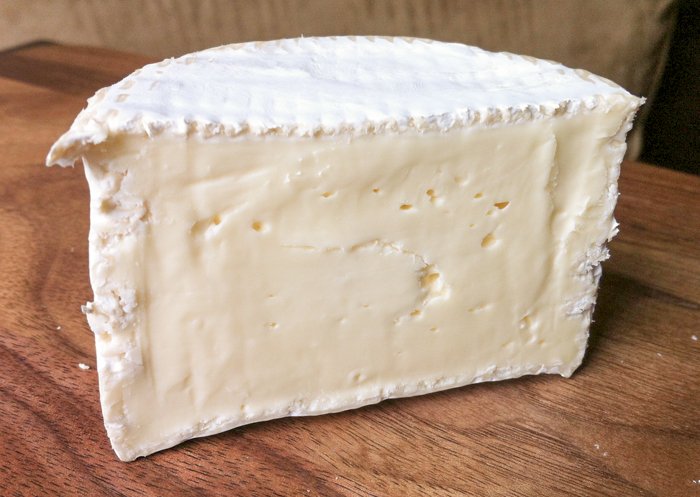Triple Creme Info
What is Triple Creme
Today in America, what we call cream cheese is a far-removed descendant of the rich, creamy, fresh and briefly cured cheese known as double and triple crèmes. Originally from France, more recently they also are being produced in parts of Spain, Italy and Denmark. All are exceptionally rich and luscious and vary in style as shown here:
- BRILLAT-SAVARIN: From Normandy, this triple crème is a thick, plump, white disk, with a buttery texture and elasticity. Hot cream is added to the cows milk to up the fat content to 75%. Cured for about three weeks with a thin, bloomy rind, it should be served young.
- BOURSAULT: Invented in 1953 by Henri Boursault, a soft, triple crème with a thin-crust.
- PROVENCAL: A French triple crème cheese flavored either with herbs and garlic or with pepper.
- ST. ANDRÉ: tastes like a combination of sour cream and butter.
- PIERRE ROBERT: A buttery soft-ripened triple crème enriched with fresh cream.
- EXPLORATEUR: A soft-ripened, cows milk triple crème, with a bloomy edible rind similar to Brie.
- MARGOTIN: This French triple-crème is a mixture of cows and goats milk, which makes it a less fatty, drier cheese.
These cheeses vary in texture from very soft to semi-firm, and range from subtle creaminess to tangy and aggressive in taste.
Some are "unripened" with a fresh, delicate tang; those that are cured for about three weeks before coming to market develop a thin, bloomy crust.
Other triple and double crèmes are blended with a mixture of herbs and garlic or spices; still others have blue veining. Many are cow's milk cheeses. While double and triple crèmes vary in flavor and style, they all share a richness and creaminess.
Double and triple cream cheeses are a rather modern addition to the cheese world, most having been introduced during the early to mid 20th century.
Triple crème cheeses are the result of extra cream being added to the milk in making soft-ripened cheeses. Think .. camembert/brie taken to another level!
Triple crème cheeses are defined by law to have at least 75% butterfat (double-crèmes must contain between 60-74% butterfat). Brillat-Savarin, St. André and Explorateur, are the most readily recognized names of triple crème cheeses. However, there are many lesser-known cheeses such as Gratte-Paille and Pierre Robert; goat-cheeses like Can Pujol (also known as Nevat); and Brebrioux, a sheep's milk cheese, that are growing in status.
All About the Cream & Butterfat
Wait, don't panic yet. The way fat is measured in all cheese is on the basis of "fat in dry matter" or F/DM. This means that after all of the water is removed and just the solids left behind, this is how much of those solids is fat. As the water is removed, the relative percentage of fat, of course, is increased, since it is left behind in the cheese.
The primary reason for using this F/DM is actually a means to measure fat in food to help people understand just how much fat is being consumed, since water in the equation would make the percentage fat quite meaningless. The idea is to compare apples to apples here.
Therefore, in a cheese such as a high fat Brie or a double or triple cream cheese that normally has a moisture content of 45% so the actual fat level is already down to about 40% of what you are actually consuming when the moisture is factored back in.
By comparison a Cheddar can be 22-28%.
From this, you can easily see that the milk going into the vat to make a triple creme cheese must obviously be enriched with cream (unless you are working with a ewe's milk with high butterfat already) this means adding some high butterfat cream to the milk.
For example, if a normal pasteurized milk at 3.25% were to be used to make a triple cream cheese you could use:
- 10-12 oz. of heavy cream (36-40% butterfat)
- to 118 oz. of the 3.25% milk
- for 1 gallon of milk at 6% butterfat
That same 6% becomes 75% cream when all moisture is removed.
Using Raw Milk
In my cheese room here, I often use a raw Jersey milk which averages about 4.8% fat for making small Bries. When I consider my yield from this milk and the final moisture, this makes a cheese of about 60% F/DM which definitely pushes it into the 'double creme' category.
If I want to push this over the edge into 'triple creme' territory, I would only need to add about 4-5 oz of the heavy cream to 124 oz. of this 4.8% milk.
But, for this recipe we are going to make things easy to get and use pasteurized whole milk from the store and some heavy cream as noted below in the guidelines.



































